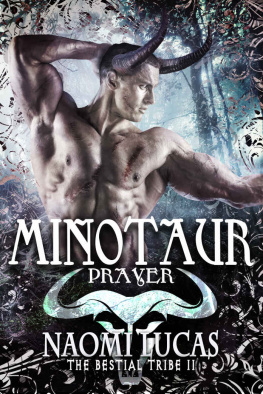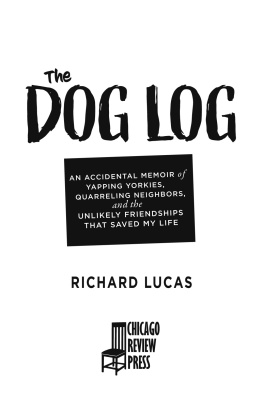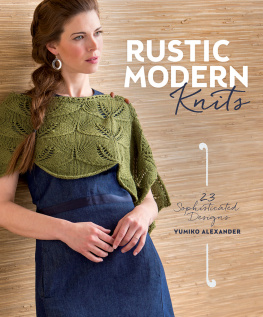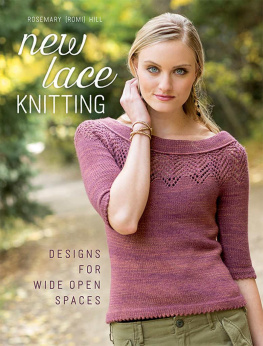SOCK-YARN SHAWLS II
16 Patterns for Lace Knitting

Jen Lucas

Dedication
For my parents, Ann and Wayne

Sock-Yarn Shawls II: 16 Patterns for Lace Knitting
2015 by Jen Lucas

Martingale
19021 120th Ave. NE, Ste. 102
Bothell, WA 98011-9511 USA
ShopMartingale.com
eBook Edition: 2015
No part of this product may be reproduced in any form, unless otherwise stated, in which case reproduction is limited to the use of the purchaser. The written instructions, photographs, designs, projects, and patterns are intended for the personal, noncommercial use of the retail purchaser and are under federal copyright laws; they are not to be reproduced by any electronic, mechanical, or other means, including informational storage or retrieval systems, for commercial use. Permission is granted to photocopy patterns for the personal use of the retail purchaser. Attention teachers: Martingale encourages you to use this book for teaching, subject to the restrictions stated above.
The information in this book is presented in good faith, but no warranty is given nor results guaranteed. Since Martingale has no control over choice of materials or procedures, the company assumes no responsibility for the use of this information.
Library of Congress Cataloging-in-Publication Data is available upon request.
eISBN: 978-1-60468-477-3
Original Source ISBN: 978-1-60468-476-6
Contents
Introduction
When it came time to start thinking about my second book, I just couldnt get shawls out of my head. My first book, Sock-Yarn Shawls (Martingale, 2013), contains lots of great patterns for small shawls, and those are still the types of projects I like to knit. But I kept thinking about all the shapes and sizes of shawls that I didnt hit in that first book. My new obsession with attach-as-you-go lace borders? Nowhere to be found in book one. Huge circular pi shawl to stop knitters in their tracks at a convention? Nope.
Sock-yarn shawls dont need to be made from just one skein of yarn. Sure, the one-skein projects are great for quick knits and perfect for wearing under your coat on a blustery winter day, but sometimes you want something more substantial. Since my sock-yarn stash (and lets be honest, yours too) has only grown since Sock-Yarn Shawls first hit yarn shops and bookstores, it made sense to explore knitting shawls that use more yarn. Maybe that will help me get the yarn stash under control!
The patterns in this book are organized into three sectionsSmall Shawls, Midsize Shawls, and Large Shawls. In the first section, the shawls can be knit with one skein of sock yarn, using 450 yards or less of yarn. This is a great start for new shawl knitters, as the projects dont require a lot of time or yarn to complete. If you enjoyed the patterns from the first book, you are sure to find something you will love in this section.
The second section features patterns that require a little more yarn. Some of the patterns require two skeins of the same yarn while others give you the freedom to play around with yarn and color choices, as youll be using two different-colored yarns. The projects in this section take between 450 and 900 yards of yarn.
Finally, in Large Shawls, you will find shawls that require 900 yards or more of yarn to complete. Here youll find beautiful multicolored shawls and circular pi shawls. If youre looking for a challenge with a beautiful cozy shawl as a prize, then start here. The patterns in this section are a little more difficult, but the hard work will be worth it! Youll be turning heads with these projects.
While the patterns are split into sections by size, maybe you want to change the size of your shawl and make it larger or smaller. In a few of the patterns you will find a tip box on how to adjust the size of the shawl if you wish.
I hope you enjoy the patterns in this book. Let the sock-yarn-shawl knitting obsession continue!

Choosing the Right Yarn
Youre ready to knit your sock-yarn shawl, but how do you pick the right yarn? In Sock-Yarn Shawls, I discussed some considerations for choosing yarn, which are just as important for knitting the projects in this book.
Yardage is probably the most important consideration when choosing your yarn. Lots of sock yarn is hand-dyed, making it nearly impossible to purchase another matching skein if you run out. Some types have less than 400 yards, while others contain as much as 450 yards. So, just like with any project, make sure you check the yarn label for yardage (and other details) before you buy.
Its also important to consider the color of the yarn. Variegated yarn is beautiful, but not always the best choice when it comes to lace projects. If the shawl contains a very small lace motif, you can often get away with a more variegated yarn. However, if the pattern has a large lace motif, the yarn and stitch pattern are going to fight each other and it will be difficult to see the lace pattern through the yarn.
For larger projects that use one color of yarn, youll want to consider alternating skeins of yarn for the duration of the project, especially when using a hand-dyed yarn. For example, the Lycopod () shawls use beautiful hand-dyed yarns. But even when these yarns are dyed at the same time, they dont always match perfectly. Such is the nature of hand-dyeing. To ensure your shawl looks like one color throughout, switch skeins every two rows. That way, the slight differences in skeins blend together subtly, rather than creating a noticeable difference when you switch skeins midway through the project. In the swatches at left, one was knit by alternating skeins of hand-dyed yarn, and the other was knit by switching to a new skein halfway through. See the difference?
So, dig into that sock-yarn stash of yours and find a skein or two to start your shawl knitting!

In this swatch, the skeins were alternated every two rows, blending the slight color differences.

In this swatch, skeins were switched halfway through, making for a noticeable color change.
A Note about Gauge
All gauges listed in this book are based on a washed, blocked swatch. Take time to check that gauge so you wont run out of yarn!
Usingand MovingStitch Markers
When it comes to repeating a set of stitches across a row, some knitters find it helpful to place a stitch marker after each repeat. You can end up with a lot of stitch markers on the needle when you do this, but it can help you keep track of where you are in the pattern. However, placing a stitch marker at each lace repeat in the row can cause issues, depending on how the lace is set up. In some cases, you may have to borrow a stitch from the next repeat in order to complete the repeat you are working. This can become a little confusing, so lets look at an example.


















